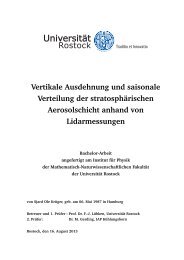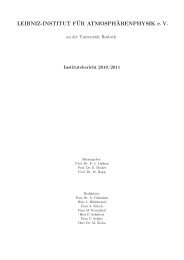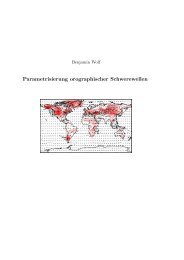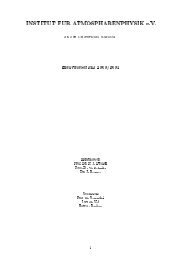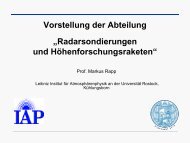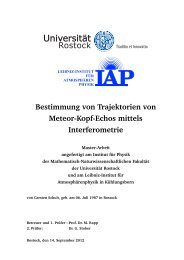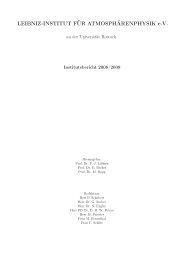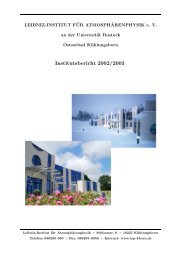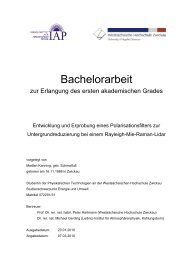Polar mesosphere summer echoes (PMSE): review of ... - HAL
Polar mesosphere summer echoes (PMSE): review of ... - HAL
Polar mesosphere summer echoes (PMSE): review of ... - HAL
You also want an ePaper? Increase the reach of your titles
YUMPU automatically turns print PDFs into web optimized ePapers that Google loves.
M. Rapp and F. J. Lübken: Review <strong>of</strong> <strong>PMSE</strong> 2625<br />
particle distribution show indeed all the features predicted<br />
by Rapp and Lübken (2003a). In particular, Rapp et al.<br />
(2003a) checked if the small scale fluctuations <strong>of</strong> electrons<br />
and charged particles are indeed anticorrelated and if the<br />
spectra <strong>of</strong> these small scale fluctuations indeed show the<br />
spectral form as predicted from a combination <strong>of</strong> the theory<br />
by Batchelor (1959) (in the case <strong>of</strong> active turbulence)<br />
and Rapp and Lübken (2003a) (in the case that the active turbulent<br />
activity has stopped, i.e., in the absence <strong>of</strong> an inertial<br />
subrange in the energy spectrum <strong>of</strong> the velocity fluctuations).<br />
In Fig. 31 data samples <strong>of</strong> such observed disturbances in<br />
the electron and charged aerosol number density as measured<br />
during flight ECT02 in 1994 are presented (see Havnes et al.,<br />
1996a,b, for more details on this data set). In panels (a) and<br />
(b), the anticorrelation between the two data sets is obvious<br />
with corresponding correlation coefficients as large as<br />
∼−0.8. Panel (c) shows one example, where the instruments<br />
did not observe any fine scale structure and panel (d) shows<br />
one example where in fact a strong positive correlation between<br />
electrons and negatively charged aerosol particles was<br />
observed. A possible explanation <strong>of</strong> such a feature was presented<br />
in the model study by Lie-Svendsen et al. (2003) who<br />
proposed that a positive correlation could either occur in the<br />
in the presence <strong>of</strong> large and hence quickly sedimenting particles<br />
or in the presence <strong>of</strong> evaporating particles (see Fig. 32).<br />
In a recent study, Blix et al. (2003b) analyzed similar observations<br />
together with simultaneous temperature measurements<br />
and found indeed support for the idea that evaporating<br />
ice particles are causing the observed positive correlations.<br />
In any case, such features have only been observed at the<br />
bottom <strong>of</strong> <strong>PMSE</strong> layers and must be considered as a specialty<br />
whereas the standard shows indeed the anticorrelation<br />
predicted by multipolar diffusion theory.<br />
Rapp et al. (2003a) further considered the spectral shape<br />
<strong>of</strong> small scale disturbances in the electron and charged particle<br />
distribution. Based on the model <strong>of</strong> Rapp and Lübken<br />
(2003a) they found that the general spectral shape acquired<br />
during a phase <strong>of</strong> active neutral air turbulence (as described<br />
by Batchelor, 1959) should develop according to<br />
Ɣ(k, t) = 2χ √ ν<br />
(−2l<br />
k ɛ · exp B 2 k2) ·e −D Ak 2t , (6)<br />
} {{ }<br />
Batchelor, 1959<br />
where the underbraced part <strong>of</strong> the equation is the power spectrum<br />
at the time the neutral air turbulence stopped (Batchelor,<br />
1959). Here, χ is the rate at which fluctuations <strong>of</strong> the considered<br />
tracer are dissipated, l B =(νD 2 /ɛ) 1 4 is the so-called<br />
Batchelor-scale, and D denotes the diffusion coefficient <strong>of</strong><br />
the tracer. Hence, power spectra <strong>of</strong> electrons and charged<br />
particles should reveal a viscous convective subrange with its<br />
prominent k −1 -power law as predicted by Batchelor (1959)<br />
even a considerable time after the active neutral air turbulence<br />
has stopped. Indeed, the power spectra <strong>of</strong> the fluctuations<br />
shown in Fig. 31 reveal indications <strong>of</strong> a viscous con-<br />
Fig. 32. Electron (dashed curves) and positive ion (solid curves)<br />
density perturbations at the end <strong>of</strong> model runs for different values<br />
<strong>of</strong> the aerosol particle evaporation rate I a . For comparison, model<br />
results neglecting the influence <strong>of</strong> particle evaporation are shown in<br />
the upper left panel. This figure is reproduced from Lie-Svendsen<br />
et al. (2003), copyright by the American Geophysical Union.<br />
vective subrange and hence confirm these ideas (see Fig. 33).<br />
Rapp et al. (2003a) also tried to classify the spectra shown<br />
in Fig. 33 as ‘actively turbulent’ or ‘fossil’ based on neutral<br />
air turbulence measurements onboard the same sounding<br />
rocket and attributed spectrum (a) as ‘active’ whereas spectra<br />
(b) and (d) were ‘fossil’. However, Rapp et al. (2003a)<br />
also pointed out that turbulence and plasma measurements<br />
were conducted during different parts <strong>of</strong> the rocket trajectories,<br />
i.e., the plasma measurements were made on the ascent<br />
and the turbulence measurements were made on the descent<br />
part <strong>of</strong> the rocket trajectory. Hence, this classification must<br />
be considered with some caution since the turbulent structure<br />
(as well as the structure <strong>of</strong> the plasma pr<strong>of</strong>iles) might be<br />
horizontally non-uniform.<br />
In any case, all the results regarding small scale observations<br />
<strong>of</strong> plasma consituents at <strong>PMSE</strong> altitudes are consistent<br />
with the theoretical ideas described above suggesting that<br />
<strong>PMSE</strong> can be explained by a combination <strong>of</strong> active and fossil<br />
turbulence acting on the large and heavy charged aerosol particles<br />
which are subsequently mirrored in the electron number<br />
density distribution that becomes visible to a VHF radar.<br />
www.atmos-chem-phys.org/acp/4/2601/ Atmos. Chem. Phys., 4, 2601–2633, 2004



